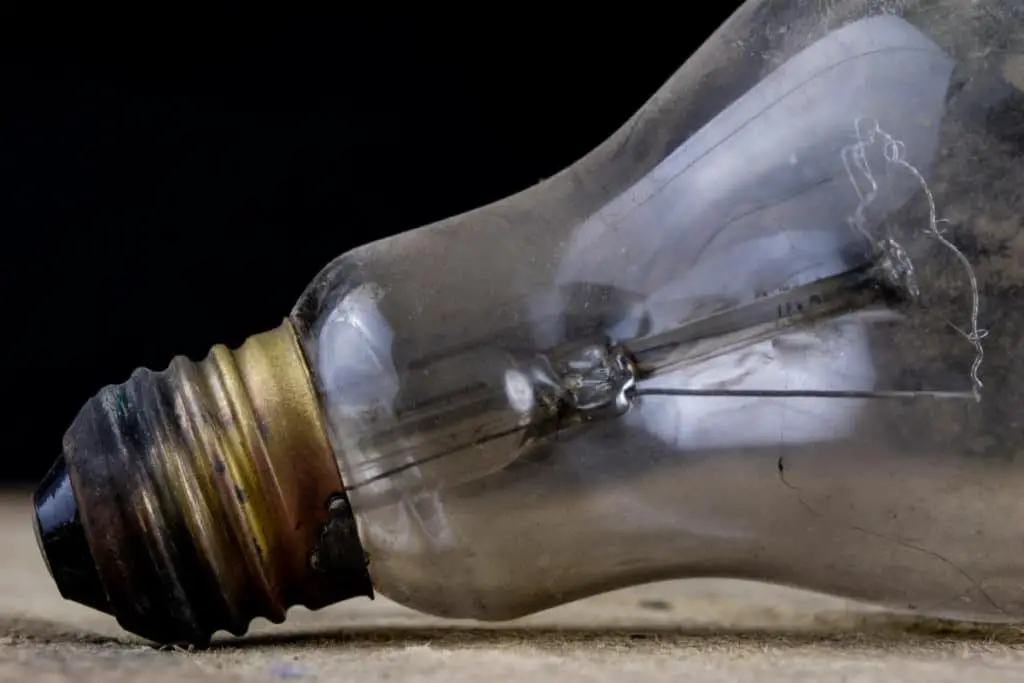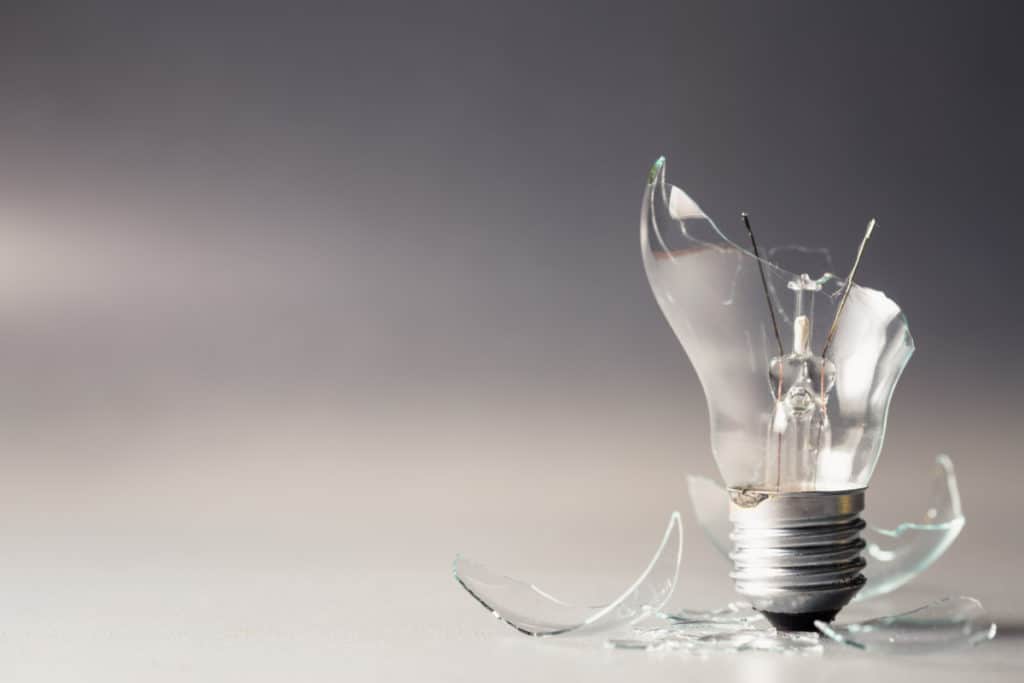
Light bulbs are the classic symbol of modernity. Because of this, they often need to be thrown away and replaced by newer, more modern light bulbs.
While incandescent light bulbs can be disposed of safely in the trash, CFL bulbs and LED bulbs contain toxic materials that must be recycled in order to be safely prevented from entering the environment. Halogen bulbs are not toxic, but can’t be easily recycled because they are full of halogen gas.
Let’s take a look at the recommended practices when getting rid of each of these kinds of light bulbs, and then the best way to safely prepare broken bulbs that contain toxic materials for disposal.
Incandescent Bulbs
Incandescent light bulbs are probably the easiest variety of light bulbs to dispose of, as they are neither toxic nor filled with gas. These can be simply thrown away, although pretty much all of the bits in an iridescent bulb are recyclable as well. However, since they are made with very thin glass that is likely to break, there are certain steps that you should take to ensure that they don’t break and hurt waste management workers.
Wrapping bulbs broken or intact in paper or plastic is the quickest and safest way to prevent the glass from cutting through you, your garbage man, or your trash bag.
CFL Bulbs
CFL bulbs may be more energy-efficient than incandescent bulbs, they are filled with mercury, which can be a danger to the entire community if it gets into the water or soil. Fortunately, the mercury in CFLs is easily recycled, as are the rest of the components that make up a CFL bulb.
Because of the mercury content of CFLs, many communities won’t accept them in their waste disposal plants. While in most of the US this is decided on a town-by-town or county-by-county basis, it is against the law in California, Maine, Massachusetts, New Hampshire, Vermont, and Washington.
Before throwing away CFL bulbs, check with your local authority what the rules are on the topic. If possible, it’s probably best to recycle CFLs even if it is legal to throw them away, since it’s probably best practice to not dump mercury into the environment.
You may also be able to take your used CFL bulbs to a retailer such as Ikea or Home Depot. However, like with other places you should be sure to call ahead and ask whether the particular location you plan on visiting actually participates in the relevant programs.
Finally, you may be able to mail the bulbs to a recycling center that accepts them. Many CFL organizations sell recycling kits that allow you to easily mail your old light bulbs off somewhere they can deal with them. To get one, you go to a website such as Think Green From Home and order one, paying for shipping and handling. You follow the instructions you get with the box, fill it up with CFLs, then take it to the post office and send it off.
It should end up at a recycling center.
Fluorescent Tubes
Like CFLs, fluorescent tubes contain mercury. The primary difference is that fluorescent tubes are long, slim glass tubes that are incredibly easy to break. Because of this, many garbage disposal and recycling plants won’t pick them up. This means that you will probably need to bring the tubes to the recycling plant yourself.
LEDs
While LEDs do not contain mercury, they do contain both lead and nickel, which are just as toxic and dangerous in soil and water. Because of this, it is probably a bad idea to toss them into landfills, and many recycling plants do not accept LEDs for recycling either.
Fortunately, there are many specialized recycling plants that are able to process LEDs. If possible, you should save your old LEDs to be taken to a place like this to avoid getting those dangerous heavy metals in the environment.
Despite all the hassle, LEDs are the most efficient and longest-lasting light bulbs on the market today. This means that while they may be difficult to dispose of easily, they are still probably worth purchasing instead of iridescent or CFLs.
Halogen Lights
Halogen lights are weird because they can’t really be recycled in the same way most light bulbs can. Because the glass used to produce a halogen lamp is actually made up of quartz, it can’t be melted with glass without making the entire batch that it’s melted in unusable.
Halogen lights can still be recycled, they just can’t be mixed with other glass products. Taking them to the recycling center separately in a well-labeled bag is probably the best way to solve this problem.
They aren’t hazardous either, so they can be thrown away safely without worry.
Other Bulbs Containing Mercury
While most kinds of light bulbs don’t have any kind of mercury in them, there are a fair number of varieties in the fluorescent bulb family. All of these different kinds of light bulbs need to be disposed of the same way as CFLs or fluorescent tubes, depending on their shapes.
Bug zappers, tanning bulbs, black lights, germicidal bulbs, high-output bulbs, and any other bulbs with the word fluorescent in their names fall into this category. Many high-intensity bulbs and neon lights also have mercury in them. Finally, any light bulb that has the word mercury in its name also has mercury in it.
Cleaning Broken Fluorescents

Because both CFLs and fluorescent tubes are incredibly delicate, it is extremely common to need to clean up the combination of broken glass and mercury dust. Fortunately, there are ways to safely deal with the hazardous materials released by a broken fluorescent light.
Before doing anything else, remove all people and pets from the room where the broken light is. Mercury has a tendency to vaporize easily, and breathing in mercury is the worst way to ingest it. turn off the central heating and cooling and open a window. This will prevent the vapors from leaking into the rest of the building, and allow it to dissipate into the outside air.
Leave the room to air out for five to ten minutes. While you’re out, gather the following materials: A glass jar with a metal lid, a stiff piece of paper or cardboard, tape such as duct tape or masking tape, and some damp paper towels.
Once it’s safe(ish) to go back into the room, do so. You may be tempted to vacuum, but this is the worst thing that you could possibly do. Vacuuming will throw all of that mercury dust and vapor up into the air.
Instead, take the paper or cardboard that you brought with you and scoop up the glass, and dust onto it. Don’t worry if you accidentally touch some of the mercury dust, as unless you have open wounds on your hands you won’t absorb it. Just make sure not to touch your face while you’re cleaning and to wash your hands thoroughly afterward.
Put the paper along with the glass and mercury dust and place it in the jar. Next, take the tape and use that to pick up any glass fragments and mercury dust that remain and can be easily seen. This should also go into the jar.
Finally, you’ll wipe down the entire area with the paper towels you brought. These should also go in the jar.
Seal the jar up and leave it outside while you contact local waste management sites to figure out how to best get rid of it. While sealing the jar should prevent it from leaking mercury vapor, it’s better to be safe than sorry.
If you don’t have an easily available jar, you can use a sealable plastic bag instead. However, a plastic bag will not prevent the mercury vapor from leaking like a jar will. Because of this, you’ll need to quickly get this bag outside once you’re done with it.
If there’s still glass on the ground after you’ve done everything, you may have no choice but to vacuum to get rid of the glass. if you must do this, keep the windows open and the central heating/cooling off. Vacuum the area where the bulb broke with the hose if possible. As soon as you’re done vacuuming, remove the bag and seal it, then take it outside with the jar. If your vacuuming cleaner has a chamber instead of a bag, wipe it down thoroughly after dumping the rest of the waste into a sealable bag.
When all is done, wash your hands and continue to air out the room where the light broke for several hours to get out any mercury vapor that might still be floating around in there. As soon as you can, take the garbage to a recycling center that will accept it. If you must do this in your own vehicle, keep your windows down so as to have an airflow to keep vapor from building up.
If you are still concerned about your health after cleaning up the CFL, call the local Poison Control Center whether you just have questions or are in an emergency.
This advice also applies to all of the other kinds of light bulbs that contain mercury.
Preventing CFLs From Breaking
There are a number of best practices when working with CFLs that can help prevent you from accidentally breaking them. The first thing you can do is make sure that whenever you’re installing or removing them, you only twist them when holding the plastic or ceramic base, and never the glass tubes.
you should also avoid overtightening the light, which can put unnecessary pressure on it. Perhaps the best thing that you can do to prevent yourself from breaking a CFL in your home is to replace the CFLs that are already in your home with LEDs, which are less delicate and easier to clean if they break.
You can also put down a towel underneath any lights you’re removing to act as a drop cloth, which may stop the light from breaking if you drop it.
Upcycling
Upcycling is the process of taking your own junk and transforming it into something that you might actually want to use. Certain types of light bulbs can be up-cycled after they’ve burnt out entirely. Incandescents are probably the best for this, as they aren’t filled with horrible toxic waste that will poison you.
A classic craft to do with old incandescent light bulbs is to turn them into Christmas Ornaments. The shape of a light bulb is pretty close to that of a snowman, a penguin, or a pear, so these are all great starting points for your creative process. Some materials that you might use include glass paints, colored paper, glitter, glue, and pretty much anything else you can think of.
You might also be able to turn old light bulbs into tiny vases. This is a little more technical and will involve you actually breaking some of the glass. Because of this, you’ll need gloves, goggles, and a plastic bag to work in to prevent shards from getting everywhere.

You’ll also need a pair of pliers, a screwdriver, and some twine. This can be a fun project and can be especially cool as decorations for a small party or another special occasion.
Many people have transformed old light bulbs into little terrariums. These are cool but might require some upkeep to maintain since bits of plants that you keep in them will likely die over time.
A more ironic take on upcycling would be to turn old light bulbs into oil lamps. This is simpler than you might expect, as once you have a wick and the proper kind of oil all you really need is to open and hollow out the light bulb.
While ideas for upcycling incandescent lights are much more common, with some creativity you can probably upcycle halogen lights as well as they are safe to work with and can be fairly simple in form.
Of course, the best thing for the environment is to keep waste like light bulbs from getting into landfills, and up-cycling does this handily. This is a good alternative if recycling is inaccessible and you’re working with safe materials.
Related Topics:
If you like the article above, here are some other similar articles you should check out!
Disposing of an Air Conditioner
